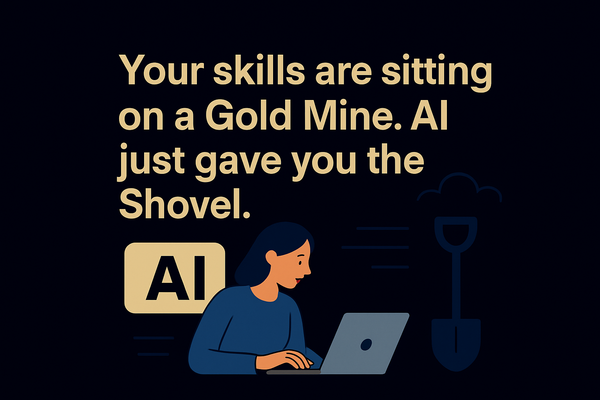AI Layoffs Surge. Build Systems to Scale and Escape Compliance.
AI-driven layoffs aren’t a threat; they’re a timestamped signal. While 78% of firms use AI daily, uneven adoption and shifting budgets open lanes for those who build systems, not resumes.

AI layoffs aren't a threat. They're a timestamp on the W‑2 illusion.
The math is brutal: at least 10,000 roles directly tied to generative AI adoption according to industry trackers. At the same time, recent indices show 78% of companies already using AI daily, 90% planning expansion by 2026, and enterprise AI API usage up 40% last quarter.
Reality over rhetoric: headcount is being converted into systems. The market is not eliminating work—it's eliminating payroll inefficiency.
Here's what most people miss: adoption is uneven and budgets are fluid. East Coast enterprise adoption is roughly 25% higher than several Midwest regions. That asymmetry is an arbitrage window. When capability spreads faster than comprehension, interpreters make the money.
Corporate loyalty is dead. Optionality is the new tenure.
The system is designed to compress cost and externalize delivery. That means fewer seats and more spend on outcome-based vendors. Your highest-leverage move isn't polishing a resume—it's packaging a system that solves a problem business leaders can justify within this quarter's budget.
Layoffs are the symptom. Systems are the cure.
The Economics of Complexity Concentration
Second-order effect: as AI displaces routine tasks, complexity concentration rises. Companies don't need more people; they need fewer people orchestrating smarter systems. Multi-agent architectures are projected to automate roughly half of routine business tasks by mid‑2026.
That doesn't make your expertise obsolete.
It makes your judgment the scarce control layer, with agents doing the legwork.
The implication is clear: build a parallel income system that multiplies your judgment instead of renting your time.
Stop optimizing someone else's machine. Start owning your own.
The System Architecture Protocol
The protocol is simple, but not easy: Diagnose. Package. Automate. Distribute.
Phase One: Diagnose Reality
Use layoff trackers as market intelligence, not fear fodder. List the roles getting cut in your function—finance ops, marketing analytics, HR screening, sales enablement, compliance reporting. Convert each role into processes. Identify the ten steps inside those processes that consume hours but require little judgment.
You're looking for expensive repetition.
Phase Two: Package the Outcome
Pick one problem that costs a company roughly five figures per year in wasted labor or delay. Define a standardized outcome with three artifacts: a quantified before/after metric, a recurring deliverable (dashboard, report, or workflow), and a simple service-level promise.
Outcomes sell; task lists don't.
Phase Three: Automate the Pattern Work
Use off‑the‑shelf tools—Claude or Gemini for analysis, an automation layer for data movement, and template generators for deliverables. Build judgment gates where your expertise approves or overrides agent output.
Don't write code. Orchestrate.
Phase Four: Distribute Like Software
You're building a one‑person agency that behaves like software. Offer a 48‑hour proof of value that demonstrates time saved and error reduced on the client's own data. Price monthly. Retain oversight. Remove yourself from routine execution.
Most won't ship because they wait for perfect. Ship because the market rewards outcomes, not elegance.
The 14-Day Implementation Sprint
- Day 1–3: Audit and Selection Inventory three processes you've run that companies still do manually. Choose the one with the clearest "clock speed" (weekly or monthly cadence), the easiest data access, and a measurable acceptance test.
- Day 4–7: Process Archaeology Map inputs, transformations, and outputs. Label which steps are judgment versus pattern. Implement draft automation: data ingestion pipeline, AI analysis prompt chains, and an auto‑formatted deliverable.
- Day 8–10: Instrumentation and Validation Add metrics collection: time saved, error rate versus baseline, and a "time to first outcome" timer. Run three dry runs with sample data. Fix failure modes where the agent hallucinates or misclassifies.
- Day 11–14: Proof‑of‑Value Sprint Offer a 48‑hour micro‑engagement to two targets: a former colleague in pain and a mid‑market company you find via layoff and job boards. Deliver their own data back as a before/after.
If you do nothing else, do this: make the proof‑of‑value irresistible and time‑boxed. It de‑risks the buy and accelerates yes.
Three Numbers That Actually Matter
- Time to First Outcome (TTFO): Hours from client data intake to a usable deliverable. Target under 48 hours initially, under 24 after iteration.
- Automation Coverage (%): Percentage of delivery steps handled by systems. Target 60–80% within 30 days while maintaining quality.
- Net Revenue per Founder Hour: (Monthly recurring revenue − direct tooling costs) ÷ hours you personally worked. Target $300+ in month one, $500+ by month three.
Everything else is noise. These three numbers force reality onto the operation.
Market Intelligence: Where to Find Demand
Start where pain is loudest and permission is highest. Track public layoff lists for functions being reduced, then message leaders in adjacent teams who now need outcomes without headcount. Focus on "blind spot" industries where daily AI use still lags—regions and verticals trailing the leaders by ~25% adoption.
They have budget pressure, not capability. You supply the capability as a system.
High-Leverage System Templates
- Finance: Automated month‑end variance narratives with anomaly flags and a CFO‑ready memo.
- Marketing: Competitive landscape monitors with weekly deltas and campaign suggestions tied to verified signals.
- HR: Candidate screening triage that converts JD criteria into a structured rubric with automated shortlists.
- Operations: SOP consistency checks where agents verify process conformance against your template and escalate exceptions.
Each follows the same design: define the decision, automate the pattern recognition, and keep your judgment on the hook for exceptions.
The Asymmetric Economics
A single standardized system can serve ten clients with the same core infrastructure. If you price at $3,000 per month for a clearly quantified outcome, three clients create $9,000 MRR. With 25 founder hours per month on oversight and sales, you're at $360 per hour net of modest tooling—before you optimize.
Replace the most fragile thing in your life—single‑employer risk—with a portfolio of clients and assets.
Risk management built in: Cash flow risk is time‑boxed. Delivery risk is instrumented. Demand risk becomes your moat.
Uneven adoption is your arbitrage window. Target industries and regions with lower AI maturity and offer "AI outcomes without headcount." Use recent adoption gaps as your wedge. Where understanding lags, systems that explain themselves win.
The Strategic Choice Point
Cost of inaction versus upside of action: If you earn $300,000, every month you delay building a parallel system effectively costs ~$25,000 in forgone earning power and increases single‑point‑of‑failure risk. Meanwhile, the adoption wave compounds.
A base‑case system with five clients at $3,000 per month creates $15,000 MRR. With 60–80% automation coverage and ~30 founder hours per month, your effective rate exceeds most executive day jobs while diversifying risk across multiple buyers.
You're not trying to be cheaper than headcount. You're trying to be faster to outcomes than headcount.
Sovereignty over security. Independence over optimization.
The choice isn't whether AI replaces jobs. It's whether you convert your expertise into a system others subscribe to before someone else productizes your method. The layoffs aren't personal. They're structural. Treat them as the market's memo: build assets that compound without your constant presence.
Your salary isn't compensation. It's rent you pay to use your life.
Build the system that buys it back.
—The Catalyst
Disclaimer: The content provided by The Catalyst is for educational and informational purposes only and does not constitute financial, business, legal, or professional advice. Results are not guaranteed; outcomes vary based on individual effort, market conditions, execution quality, and regulatory constraints. References to layoffs, adoption statistics, tools, or strategies are based on publicly available sources and industry commentary as of the date of publication and may change. Any business initiative involves risk, including potential loss of capital. You are responsible for your own decisions. Consult qualified professionals to evaluate your specific situation before implementing any strategy.



